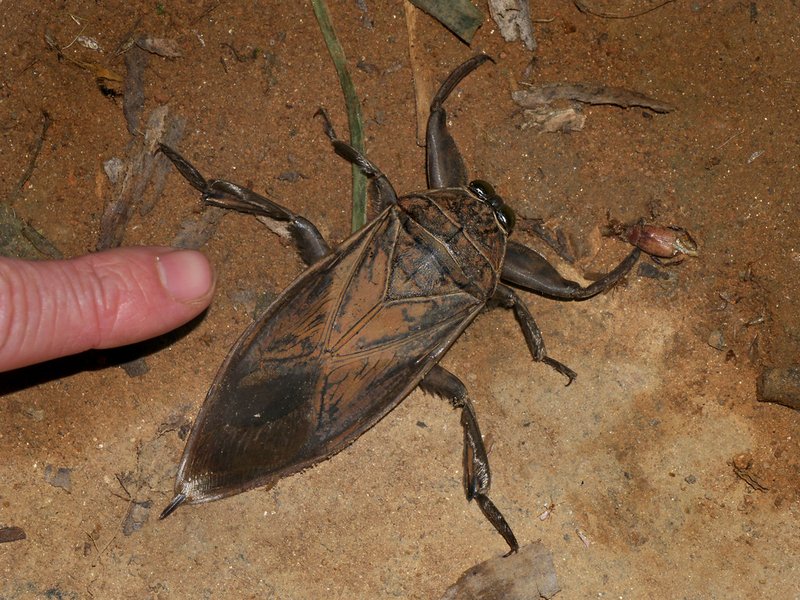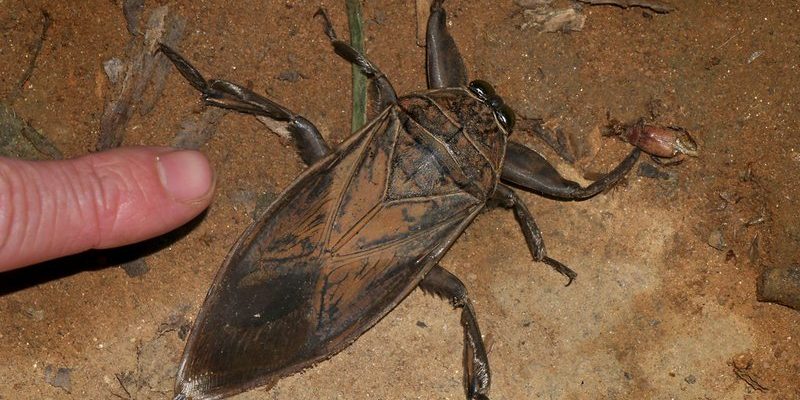
Have you ever seen a bug that looks like it belongs in a horror movie? Enter the Giant Water Bug, a fascinating creature that thrives in freshwater environments. These bugs are large, impressive predators that have a few tricks up their sleeves. With a size that can reach up to four inches long, they are not your typical household bug. Imagine a miniature alien spaceship gliding across your pond—that’s the kind of vibe these bugs give off, and they are as intriguing as they are intimidating.
Native to various regions in North America, Asia, and Africa, Giant Water Bugs possess unique adaptations that make them masters of their watery domains. They are known for their powerful bites and impressive hunting skills. You might even find them lurking about in your local water bodies, stealthily preying on unsuspecting fish and insects. If you’re curious about what makes these creatures so captivating, read on as we dive deeper into their lives and unique characteristics!
Physical Characteristics
The Giant Water Bug is aptly named for its distinct size and features. On average, these bugs measure between 2 to 4 inches long, making them one of the largest insects found in North America. With a wide, flattened body and long, paddle-like hind legs, they have evolved to become expert swimmers. Their coloration typically ranges from brown to olive green, allowing them to blend seamlessly into their aquatic environments. This camouflage is not just for show; it’s a crucial part of their survival strategy.
Their front legs are equipped with sharp pincers, perfectly designed for grabbing and holding onto prey, while their elongated, narrow mouth parts function like a straw. This is how they feed—by injecting digestive enzymes into their catch and sucking out the liquefied insides. Imagine sipping a smoothie through a straw; that’s essentially how these bugs consume their meals! This method not only showcases their predatory prowess but also ensures they can tackle prey much larger than themselves.
Life Cycle
Understanding the life cycle of the Giant Water Bug can give us a better appreciation for this creature. They undergo a process known as incomplete metamorphosis, which means they don’t have a distinct pupal stage like butterflies. Instead, they hatch from eggs laid on vegetation above water. The female uses her specialized legs to secure the eggs in a protective layer, ensuring they are safe from predators.
Once the eggs hatch, the tiny nymphs emerge, resembling miniature adults but without fully developed wings. These nymphs are just as fierce as their adult counterparts, hunting and feeding almost immediately. As they grow, they undergo several molts, shedding their exoskeletons to accommodate their increasing size. This growth phase can last several weeks, during which they continuously adapt to their environment, fine-tuning their hunting skills and learning how to navigate their territory.
Habitat
The habitat of the Giant Water Bug primarily consists of freshwater ecosystems, such as ponds, marshes, and slow-moving streams. Here, they find plenty of hiding spots among reeds and other aquatic plants, as well as ample opportunities for hunting. The stillness of these water bodies provides the perfect backdrop for their stealthy ambush tactics. You might spot them resting silently near the surface, waiting for the next unfortunate creature to wander by.
While they are quite versatile and can adapt to various environments, Giant Water Bugs prefer areas with abundant vegetation and organic debris, which serves as both shelter and a hunting ground. They are often found in regions with warm temperatures, as they thrive best in such climates. If you’re looking to observe these fascinating creatures, check out your local ponds or wetlands, especially during the warmer months!
Diet and Hunting Behavior
The diet of the Giant Water Bug is primarily carnivorous, making them skilled predators. They feed on a variety of aquatic organisms, including fish, amphibians, and other insects. With their formidable hunting adaptations, they have established themselves as dominant predators in their habitat. Imagine a small alligator quietly waiting under the water surface, ready to pounce; that’s the kind of patience and strategy they employ.
Giant Water Bugs utilize ambush tactics to catch their prey. They lie in wait, partially submerged and nearly invisible to the unsuspecting animals swimming by. When an opportunity arises, they strike with lightning speed, using their sharp front legs to capture their prey. Once they grab hold, they inject venom into their catch, paralyzing it and beginning the digestion process right away.
Predators and Threats
While Giant Water Bugs are at the top of the food chain in their aquatic environments, they aren’t without threats. Birds, fish, and even other insects can pose a danger to these giant bugs. Their size does grant them some protection, but their nymphs are particularly susceptible to predation. Additionally, habitat destruction and pollution can significantly impact their populations. As wetlands and ponds are drained or contaminated, these bugs struggle to find suitable living conditions.
Humans also pose a unique threat to Giant Water Bugs. Their habitats can be affected by agricultural runoff and urban development, leading to a decrease in their numbers. Conservation efforts aimed at protecting freshwater ecosystems can help preserve these remarkable creatures and ensure they continue to thrive in their natural habitats.
Interesting Facts
The Giant Water Bug is full of surprises! For starters, did you know they can produce a loud noise when threatened? This sound is made by vibrating their bodies and can help scare off potential predators. Furthermore, they are known to be quite resilient; some species can survive for short periods out of water, making them surprisingly adaptable!
Another curious fact is that Giant Water Bugs have been used as a food source in certain cultures, particularly in Southeast Asia. They are often fried or used in traditional dishes, showcasing their versatility beyond just being pond dwellers. This adds a whole new layer to understanding how humans interact with these fascinating insects.
Table: Quick Facts about Giant Water Bugs
| Scientific Name: | Belostomatidae |
| Size: | 2–4 inches |
| Habitat: | Freshwater ponds, marshes, streams |
| Diet: | Carnivorous (fish, amphibians, insects) |
| Speed: | Fast swimmers |
| Lifespan: | Up to 1 year |
How to Observe Giant Water Bugs
If you’re eager to catch a glimpse of these incredible creatures, there are a few tips to follow. First, visit a local pond or wetland during the warmer months—spring and summer are ideal times for spotting them. Look for areas with tall vegetation or slow-moving water, as this is where they like to hang out. You might even find them resting on lily pads or lurking just beneath the water’s surface.
Patience is key! These bugs can be quite elusive, so it’s important to move slowly and quietly to avoid startling them away. Consider bringing along a small net or container if you’d like to catch a closer look, but remember to handle them gently and return them to their habitat after observing. This respect for their environment helps ensure that they continue to thrive for future generations to enjoy.
The Giant Water Bug is a captivating creature that plays an important role in its ecosystem. With its impressive size, unique hunting tactics, and fascinating life cycle, it’s hard not to be drawn in by its mysterious nature. While they may seem intimidating at first glance, these bugs are a marvel of nature, reminding us of the incredible diversity of life found in the world around us. So next time you find yourself near a pond, take a moment to appreciate the hidden wonders like the Giant Water Bug that contribute to the beautiful tapestry of life.
FAQ
Are Giant Water Bugs dangerous to humans?
While Giant Water Bugs are fierce predators, they generally pose little threat to humans. However, their bite can be quite painful, akin to a bee sting. If provoked, they may defend themselves, so it’s best to admire them from a distance unless you’re very familiar with handling them.
What do Giant Water Bugs eat?
Giant Water Bugs have a carnivorous diet, primarily feeding on fish, amphibians, and other insects. Their hunting techniques are fascinating; they inject venom into their prey to digest it externally before consuming the liquefied remains.
Where can I find Giant Water Bugs?
You can find Giant Water Bugs in freshwater habitats such as ponds, marshes, and slow-moving streams. They prefer areas with ample vegetation and organic debris, which provides both cover and a hunting ground.
How can I safely observe Giant Water Bugs?
To safely observe Giant Water Bugs, visit a local pond during warmer months and approach the area quietly. Look for them resting on lily pads or camouflaged among reeds. If you wish to catch a closer look, consider using a net but always be gentle and return them to their habitat.
Do Giant Water Bugs have any predators?
Yes, despite being top predators in their habitats, Giant Water Bugs face threats from birds, fish, and even other insects. Their nymphs, in particular, are more vulnerable to predation, making them susceptible to a variety of threats.
Can Giant Water Bugs survive out of water?
Giant Water Bugs have some adaptability and can survive for short periods out of water, but they are most comfortable and thrive in aquatic environments. Extended periods away from water can be detrimental to their health.
How long do Giant Water Bugs live?
The lifespan of a Giant Water Bug can reach up to one year, depending on environmental conditions and availability of food. Their life cycle, from egg to adult, typically lasts several weeks to months, depending on various factors.
Are Giant Water Bugs harmful to pets?
Giant Water Bugs can potentially harm pets if they attempt to catch or play with them, as their bite is quite painful. It’s wise to keep an eye on pets near bodies of water and educate them about avoiding contact with these fascinating bugs.
What impact do Giant Water Bugs have on the ecosystem?
As predators, Giant Water Bugs play a crucial role in maintaining balance within their ecosystems. They help control populations of smaller fish and aquatic insects, which in turn supports the health of their habitats and contributes to biodiversity.
Can humans eat Giant Water Bugs?
In some cultures, particularly in Southeast Asia, Giant Water Bugs are consumed and considered a delicacy. They are often fried or used in traditional dishes, showcasing the diverse ways humans interact with these intriguing insects.
How do Giant Water Bugs reproduce?
Female Giant Water Bugs lay their eggs above water on vegetation. The female secures them in protective layers to ensure their safety. After hatching, the nymphs closely resemble their adult counterparts and begin feeding almost immediately.

